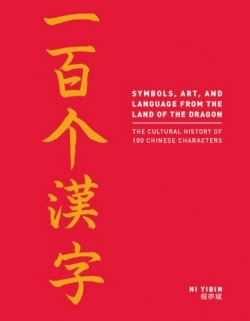Symbols, Art, and Language from the Land of the Dragon
The Cultural History of 100 Chinese Characters
Electronic means of communication have their advantages, speed and wide distribution chief among them. At times, however, today’s technology can feel slippery, abstract, and anonymous, disconnected from real humans or anything humans can touch. If your neurons are starting to atrophy from the lack of deep thought, stretch them out again with Symbols, Art, and Language From the Land of the Dragon. Ni Yibin, a scholar of Chinese iconography, has created a lovely book that both informs and renews a sense of language as cultural experience. No key strokes here, but brush strokes, and the cultural history of 100 Chinese characters.
The Chinese language is written, not with an alphabet with a limited number of letters, but with thousands of characters, each of which carries a component of meaning, or sound, or both. A recent official character set used for computers had 27,533 characters; about 3,000 of them will enable you to read 99 percent of Chinese texts. Characters are built from 400 root characters, or components, which have their origins in pictographs and earliest forms of Chinese writing. Chinese is unique for its long and continuous development, and because it is used by more people than any other writing system in the world.
In a lengthy introduction, Ni charts the history of Chinese writing through four distinct stages of development. Beginning as pictographs—images of objects, or objects combined to indicate an action—the characters became more stylized as they were circulated. Earliest forms of these characters occurred 8,000 years ago, and by the eleventh and twelfth centuries BCE, they were part of a mature writing system. The First Emperor of the Qin dynasty unified the several regions of China under one rule in 221 BCE, and created an official script—the xiao-zhuan, or seal script—to standardize different regional writing forms and reinforce the empire’s unity. The Han dynasty (206 BCE-220 CE) clerical script was the script of government clerks; it underwent reforms that moved it away from pictographic and toward calligraphic forms. Although additional scripts have since developed, the Han form remains the version that calligraphers still use today.
Calligraphy is revered above all art forms by the Chinese; the calligrapher communicates not only the meaning of the text, but also artistic sensibility, and formal and spiritual beauty. What is created is the “perfect contrast of black ink and white paper, light and shadow, energy and calm. The process of writing can, therefore, be considered a form of early performance art, and a connoisseur should be able to reconstruct the performance from a finished piece of calligraphy, empathizing with the mood and intention of the master…”
After this lofty introduction, Yibin profiles 100 characters, organized into four groups: Nature, Mankind, Objects, and Qualities. Each character is given a long look; its specific history of development, a bit of storytelling about the cultural significance of the idea it represents, and a large calligraphic rendition combine to make short and fascinating profiles.
For example, the character for “beauty” or “beautiful” is mei, and in its earliest form, it combined the horned head of a sheep or goat with the symbol for “big.” Perhaps a picture of a fattened animal, and the wealth it represented, was the ancients’ best way to indicate something beautiful. Or perhaps this character “reflects an ancient belief that plumpness and a sheep-like gentleness and docility were markers of feminine beauty…” The word mei is also a homophone for the words for “eyebrow” and “plum blossom,” and their intersections make for interesting word play. “To this day an attractive young woman might find herself addressed as mei mei, ‘beautiful eyebrows’.” The word mei is also part of the word for “America”: meiguo or “beautiful country.”
Ni Yibin is a lecturer and author, who taught Chinese art and culture at the National University of Singapore, and who has contributed to other publications, including China (Duncan Baird). In recent years, he has become an independent scholar, deciphering lost story scenes in Chinese art. His text is illustrated with full-color reproductions of photographs, Chinese scrolls, embroidery, and paintings.
Ni tells us, “It is said that the birth of Chinese characters was so important for the world that nature acknowledged their creation with mysterious miracles, like showers of grain and the howling of demons.” Ah—with that kind of natural reception, how can we remain unmoved by a visit to the origins of language? Ni provides not only food for thought, but insight into a vigorous and still-evolving culture, and the pure pleasure of turning the pages of a beautiful book.
Disclosure: This article is not an endorsement, but a review. The publisher of this book provided free copies of the book to have their book reviewed by a professional reviewer. No fee was paid by the publisher for this review. Foreword Reviews only recommends books that we love. Foreword Magazine, Inc. is disclosing this in accordance with the Federal Trade Commission’s 16 CFR, Part 255.

